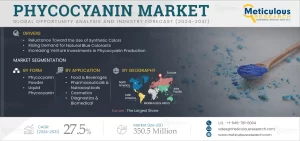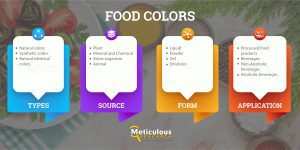The Phycocyanin market was valued at $49.5 million in 2023. This market is expected to reach $350.5 million by 2031 from an estimated $64.1 million in 2024, at a CAGR of 27.5% during the forecast period from 2024 to 2031.
In recent years, the use of synthetic color additives in food, beverages, pharmaceuticals, and cosmetics has significantly declined due to growing consumer awareness about potential health risks and increasingly stringent regulatory measures worldwide. Once valued for enhancing product appeal, synthetic dyes are now being replaced by safer, natural alternatives as both governments and consumers prioritize health and sustainability. This shift presents new opportunities for natural colorants, such as phycocyanin, to capture the market.

Download Sample Report Here @ https://www.meticulousresearch.com/download-sample-report/cp_id=5126
Regulatory Crackdown on Synthetic Colors
Regulatory agencies across the globe have established strict guidelines to control the use of synthetic food colors, impacting their adoption. In the U.S., the Food and Drug Administration (FDA) oversees the use of artificial additives, ensuring that any synthetic food color used meets stringent safety and quality standards. Products containing non-compliant colorants or unlisted synthetic dyes are deemed adulterated under the Federal Food, Drug, and Cosmetic (FD&C) Act.
The U.S. has banned synthetic food colors from over 200 food products to address public health concerns. Likewise, the European Union requires all food color additives to comply with Regulation EC 1333/2008, ensuring safety and transparency in food manufacturing. South American countries, led by Brazil, have also adopted rigorous regulations, focusing on food safety and accurate health claims.
Disparities in regional regulations—such as bans on certain colorants in Europe and restrictions on labeling in the Gulf Cooperation Council (GCC) countries—are complicating global trade. Companies must navigate these diverse regulations to maintain market access, adding operational complexity and increasing production costs.
Consumer Health Concerns Driving Change
The rising incidence of allergic reactions and other health issues linked to synthetic food colors has increased consumer demand for natural alternatives. Research conducted by the California Office of Environmental Health Hazard Assessment (OEHHA) indicates that synthetic dyes can trigger a range of adverse effects, including allergic disorders, skin irritation, digestive issues, and behavioral problems in children. Studies have shown that eliminating synthetic colors from children’s diets can help reduce hyperactivity and attention-related disorders.
Additionally, the African Journal of Biotechnology highlights that high consumption of tartrazine, a synthetic yellow dye, has been associated with asthma attacks, skin reactions, and even cancer. Other synthetic dyes, such as Allura Red AC and Erythrosine, have been banned or restricted in several countries due to their links to thyroid disorders and allergic reactions.
These growing health concerns have prompted governments to initiate bans and stricter controls over synthetic colorants. For example:
- Europe banned titanium dioxide (E171) as a food additive in 2021.
- Norway and Austria prohibited Yellow 5 and Yellow 6 in 2022, requiring warning labels for their presence in the European Union.
- Japan and European nations stopped trading products containing synthetic food colors in 2017.
- The UK Food Standards Agency phased out tartrazine in 2009, following research that linked the dye to behavioral issues in children.
Get Insightful Data On Regions, Market Segments, Customer Landscape, And Top Companies (Charts, Tables, Figures And More) :- https://www.meticulousresearch.com/request-sample-report/cp_id=5126
Industry Shift Toward Natural Colorants
Given the declining consumer acceptance and regulatory restrictions on synthetic dyes, manufacturers across industries are shifting toward natural color alternatives. Phycocyanin, a blue pigment derived from spirulina algae, is gaining prominence due to its safety, natural origin, and high functional value. Phycocyanin is increasingly being used in the food, beverage, pharmaceutical, and cosmetic industries to replace artificial colors.
This shift aligns with consumer preferences for clean-label products—those with minimal artificial ingredients and transparent labeling. The push for natural ingredients has extended beyond the food industry into cosmetics and pharmaceuticals, with companies opting for plant-based or algae-derived pigments over synthetic dyes.
Global Market Growth for Phycocyanin
The transition from synthetic to natural colorants is driving significant growth in the global phycocyanin market. According to Meticulous Research®, the phycocyanin market is projected to reach $279.6 million by 2030, growing at a CAGR of 28.1% from 2023 to 2030. In terms of volume, the market is expected to reach 3,587.2 tons by 2030, with a CAGR of 33.8% during the same period.
The increasing demand for phycocyanin is supported by its versatility. It is not only used as a food colorant but also offers antioxidant and anti-inflammatory properties, enhancing its appeal in the pharmaceutical and nutraceutical industries. Additionally, with rising health consciousness, more manufacturers are adopting phycocyanin to create vibrant, natural hues without compromising product safety or quality.
Regulatory Challenges and Market Opportunities
Despite its advantages, manufacturers of natural colorants like phycocyanin must still navigate complex regulatory frameworks. Compliance with regional health and safety standards is essential for market entry and approval in developed countries. This can increase operational costs, impacting the final product’s pricing and influencing consumer demand.
Moreover, producers need to address challenges related to sourcing and sustainability. Natural colorants, including phycocyanin, require specific environmental conditions and careful processing to maintain product quality. Ensuring sustainable production practices is critical to meeting both consumer expectations and regulatory requirements.
However, these challenges also present opportunities for innovation. Companies are investing in research and development to enhance the stability and functionality of natural pigments, creating new possibilities for product applications. Collaborative efforts between regulatory bodies and industry players can further support the adoption of natural colorants and reduce barriers to market entry.
Scope of the Report
By Form
- Phycocyanin Powder
- Liquid Phycocyanin
By Grade
- Food-Grade Phycocyanin
- Cosmetic-Grade Phycocyanin
- Reagent- & Analytical-Grade Phycocyanin
By Category
- Organic
- Non-organic
By Application
- Food & Beverages
- Pharmaceuticals & Nutraceuticals
- Cosmetics
- Diagnostics & Biomedical
Immediate Delivery Available | BUY THIS RESEARCH REPORT (Insights, Charts, Tables, Figures and More) –https://www.meticulousresearch.com/Checkout/40138087
Contact:
Meticulous Market Research Pvt. Ltd.
1267 Willis St, Ste 200 Redding,California, 96001, U.S.
USA: +1-646-781-8004
Europe: +44-203-868-8738
APAC: +91 744-7780008
Email– sales@meticulousresearch.com
Visit Our Website: https://www.meticulousresearch.com/
Connect with us on LinkedIn- https://www.linkedin.com/company/meticulous-research
Meticulousblog.org | Top Market Research Reports Blog – https://meticulousblog.org/






